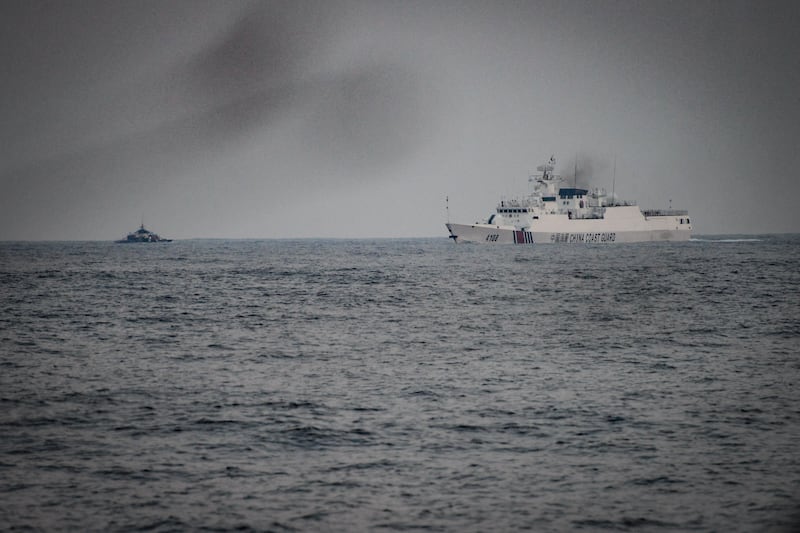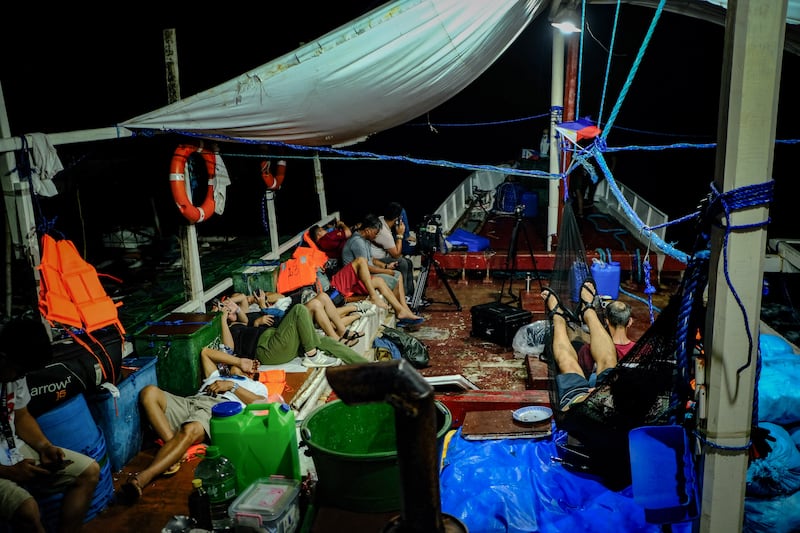A sliver of light broke the early-morning horizon, indicating fair weather ahead for our mass sea voyage to Scarborough Shoal.
It was Wednesday, May 15. Atin Ito! (This Is Ours!), a Philippine civilian coalition, was leading a convoy of boats to deliver supplies to Filipino fishermen in waters around the contested shoal in the South China Sea, known among Filipinos as Panatag Shoal or Bajo de Masinloc.
Excitement was in the air, but we were dreading the possibility of being harassed by Chinese vessels. Filipino fishermen who venture out to the shoal’s rich fishing ground complain about being routinely harassed by Chinese ships and boats, which have effectively controlled Scarborough Shoal since 2012.
Many people came to see us off at the Matalvis fish port in Masinloc, a town in Zambales province, where coalition volunteers, journalists, and foreign observers were preparing to embark on the journey.Scarborough lies 125 nautical miles (232 kilometers) off the west coast of Luzon, the Philippines’ main island.
Last December, Atin Ito! organized a similar civilian mission to deliver supplies to Filipino troops stationed aboard the BRP Sierra Madre, a grounded navy ship that marks Manila’s territorial claim at Second Thomas (Ayungin) Shoal.
That convoy was subsequently forced to turn back to shore after four Chinese ships started to shadow its lead boat.

A tall, bespectacled, elderly man gingerly approached me and said he was a supporter of the civilian mission from Manila. Upon learning that I was with the foreign press, he said: “Take care always, we are proud of you all.”
Volunteers had been arriving steadily since 4 a.m. Most were familiar faces from the first civilian supply mission. They were energetic and full of enthusiasm.
BenarNews was assigned to Boat 1, the FB Bing Bing, a wooden vessel about 22 meters (72.1 feet) long and 3 meters (9.8 feet) wide. Three other vessels were also among the main boats in the convoy.
There were about 50 of us onboard the FB Bing Bing, including some of the journalists, volunteers, and crew.

At the outset, more than 100 smaller Filipino fishing boats escorted the convoy for the first leg of its voyage before they returned to shore. The Philippine Coast Guard (PCG) sent three ships to protect the civilians aboard the boats in the convoy.
We set sail at about 7 a.m. Seeing a flotilla of scores of fishing boats accompanying us at the start was an unbelievable sight.
Agustin Bustillo, the boat captain, said, “At least now, they will see that the Filipinos can fight.”
Time to work
At around noon, food and fuel supplies were given to fishermen at around 12 to 14 nautical miles (22.2 - 25.9 km) inside the Philippines' exclusive economic zone (EEZ).
Fishermen did not hide their excitement when they deployed symbolic buoys to assert their country's sovereign rights over the West Philippine Sea, Manila's name for South China Sea waters within its EEZ. They were in high spirits, with some even cursing the Chinese for harassing them at sea.
The coalition had already accomplished the first half of its mission.

We began to file stories for the day, using every available space to write and edit stories and photos. Some did live reporting through social media.
For lunch, we were served “tinola,” a Filipino soup of chicken broth.
‘We will proceed’
The first sign of trouble emerged hours after the flotilla of smaller boats sailed back to shore and the convoy sailed on toward Scarborough Shoal.
A steady breeze had lulled many into an afternoon nap.
That’s when I saw a white ship on the horizon to our left.
It was too far out to identify, but with the help of my telephoto lens, I could read its markings: China Coast Guard 4109.
“They’re here! The Chinese coast guard are here,” I blurted, causing sudden commotion and a burst of activity.
A radio message from the PCG confirmed the approaching China Coast Guard (CCG) ship. From the captain’s deck, I heard some of the exchange of radio challenges between the Philippine and Chinese coast guards.

Journalists broke the news as it happened.
I took pictures and videos and sent updates at the same time. I was careful not to fall into the water as I aimed my camera to capture clear photos and footage of the Chinese vessel.
A few minutes after CCG 4109 appeared, another ship, CCG 4108, materialized in front of our convoy. They appeared to be maneuvering to block the boat ahead of us.
The two CCG ships shadowed the convoy and tried to block our way. Sometimes, they maneuvered dangerously close to our boats. Clearly, it was a cat-and-mouse strategy of trying to break up the convoy. Our Philippine coast guard escort, the BRP Bagacay, tried to maneuver in between our boat and the CCG ships.
At this point, I asked Rafaela David, the lead co-organizer of the mission, what her plan was.
She said: “Proceed. We will proceed.”
It was already dusk and the CCG ships were still on us.

The convoy decided to stop at one of the many fish aggregating devices deployed in the area to avoid the dangers of sailing through the dark night.
We were about 58 nautical miles (107.4 km) from the shoal.
Everyone was sending their updates. They were focused on their devices, which radiated an eerie glow in the darkness at sea.
Our office, bed and lounge
FB Bing Bing was bigger than the other boats, but we still needed to cram ourselves inside its limited space.
I parked myself at the boat’s upper deck. It was to be my working space, sleeping area, lounge area, and a place for all my stuff. It also offered a better vantage point for photographs and videos.

The deck had a flat surface – barely enough for one person – and the ceiling was so low that one could only sit and crawl when going in and out.
The ceiling was repurposed as a sleeping area, with a flimsy tarpaulin serving as a temporary cover.
Some of the journalists and foreign observers settled on the side of the main deck, which was also used as our mess hall. This became the main activity area, where we all chatted during downtime.
I must admit, I was a bit anxious at first.
But after an advance boat of the coalition, which had sailed a day earlier than the convoy and unannounced, successfully delivered supplies to Filipino fishermen near the shoal despite a Chinese blockade, I believed the mission's objective far outweighed the risks.
We had not quite reached Scarborough Shoal, but after news broke that the advance team had delivered food and fuel to Filipino fishers, the boats in our convoy turned around and headed back for the safety of home.
